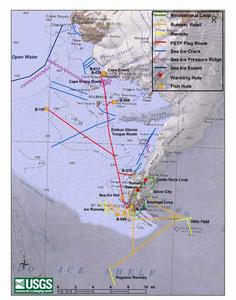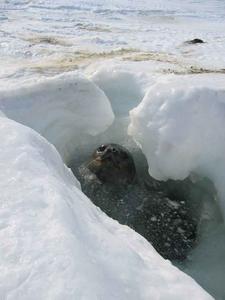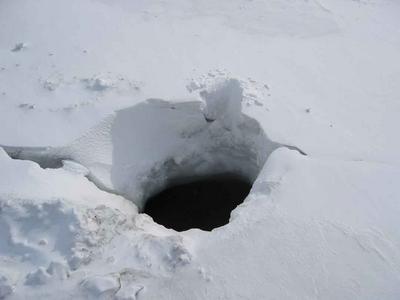22 November, 2003
This week we received the mid-November Sea Ice Report. Why should we
care about what the ice is doing? Well, first of all, we are
spending almost 99% of our time living and working on the ice.
Secondly, we are studying an animal with a high affinity for ice
cracks-the seals congregate where cracks provide easy access to the
surface. This report provides relevant information for all who live
on the ice of Erebus Bay, be they humans or seals.
At this point in time the sea ice has grown as thick as it will get
for the year and has begun its transition towards becoming warmer and
less stable. The colder the ambient air temperature, the more the ice
grows. Sea ice strength is determined by the thickness and internal
temperature; the colder the sea ice, the stronger its overall
structure. Another important fact to consider is that while the sea
ice thickens from the top down, it melts from the bottom up. Just
looking at the surface of the ice will not disclose its strengths or
weaknesses. The folks who produce the sea ice report use a number
of gauging stations to determine ambient temperatures. The sea ice
is now in what is known as a period 2 condition, where temperatures
range from 14-23F. Period 1 temperatures are less than 14F, and the
shift from period 1 to 2 is slow and gradual in comparison to the
change from period 2 to period 3 (23-27F). Last season they recorded
the change from period 2 to period 3 in the second week of December.
Since seawater here freezes at around 28F, you can see how this
subtle shift in temperature can affect its stability. Once the
temperatures approach 27 or 28F you are definitely skating on thin
ice!
While the air and ice is warming, it doesn't mean that we are all in
danger of taking a big swim anytime soon. The first year ice near
the water's edge is averaging 2m thick, with very little snow on its
surface. The multi-year sea ice near us around the Dellbridge
Islands and Cape Evans is about 2.3-2.5m thick, but is covered with
80-100cm of snow. This late season snow cover insulates the ice from
solar heating which slows the melting process. On the other hand, a
thick cover of snow can be heavy enough to depress the snow
sufficiently to push it below the sea level, subjecting it to warmer
ocean temperatures that might cause it to weaken. The ice here at
camp is at least 2 meters thick-the drill we use for our wastewater
holes is around 2 meters long-and we have yet to strike water.
So what are we actually seeing as we make our rounds of the seal
colonies? The changes in the ice are subtle-it's a time to pay
attention as we bounce across the sastrugi or wander on foot through
the colonies. Most of the prominent cracks are filled with snow,
making them harder to identify. Where the surface may have appeared
solid last week, and supported the weight of a person walking or even
driving a snowmobile, some areas now have large linear depressions or
even gaps showing at some of the more substantial crack systems. The
crack systems are also widening-where once you could easily
snowmobile across a snow-filled crack 1/2 meter wide, there might now
be a gap that is 2-4 meters wide to cross. When faced with the
question of whether it is safe to cross, we will probe the crack with
an ice axe to see if it is hard enough to support the weight of the
snowmobile. If it's not hard enough, it's time to drive along the
crack until you can find a spot that is either strong enough or
narrow enough to provide support on the solid snow on each side as
you cross. Misjudging the cracks probably would not mean a sudden
conversion from snowmobile to jet ski as you hit the water below, but
it would mean spending the rest of the day with a shovel and tow rope
trying to extricate your snowmobile from the ditch. The basic
message here is to pay attention and take the time to find a safe
crossing if there is any doubt.
Daily Haiku:
Sea ice is changing
The cracks are growing wider
Walk carefully now

This is the map that is attached to the sea ice report and details prominent cracks in the ice.

This seal's breathing hole takes advantage of the thinning sea ice and snow cover. This was one of the more scenic seal holes I've seen.

Here's another seal hole. You can see how deep the snow is on top of this ice layer.
Contact the TEA in the field at
.
If you cannot connect through your browser, copy the
TEA's e-mail address in the "To:" line of
your favorite e-mail package.
|
